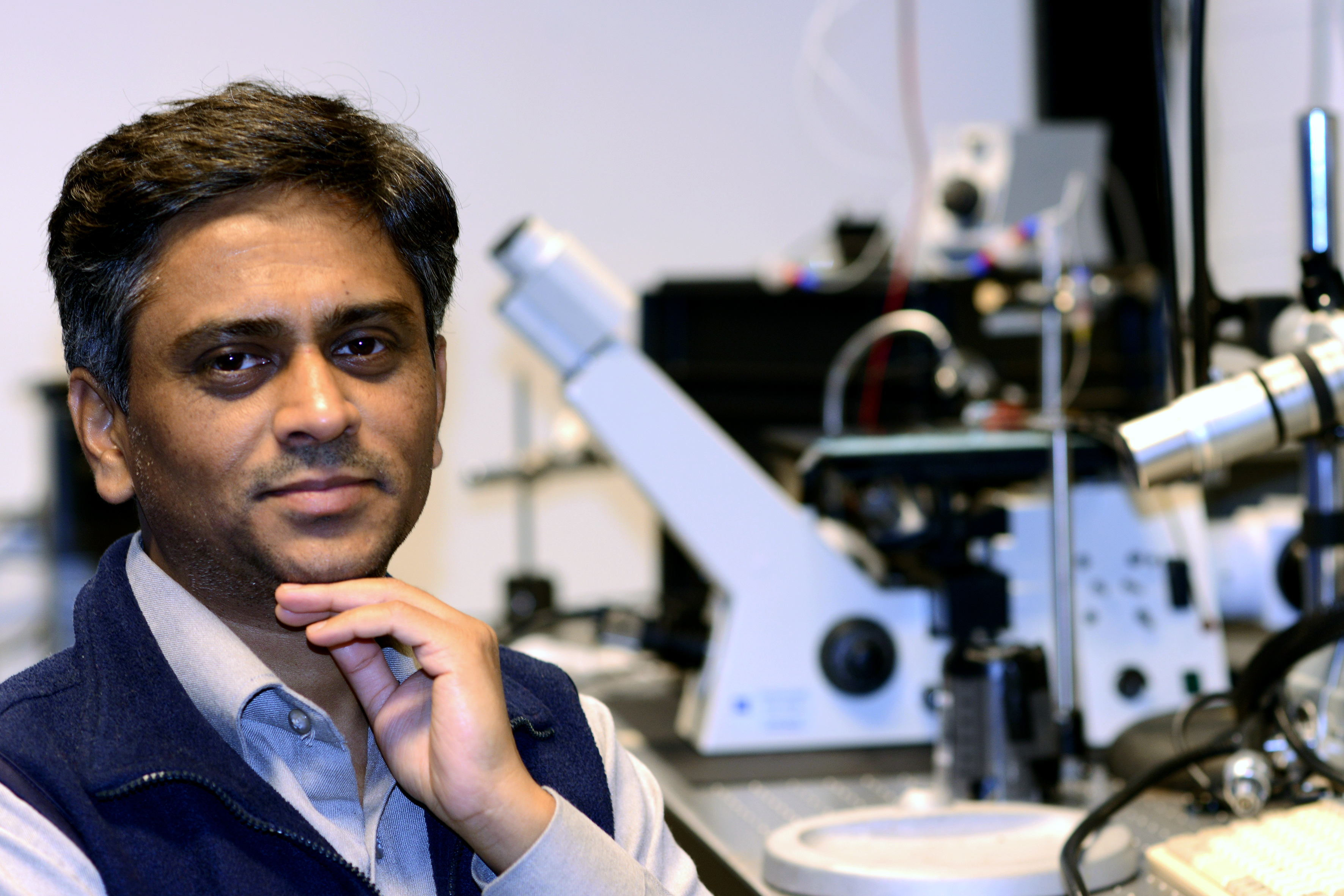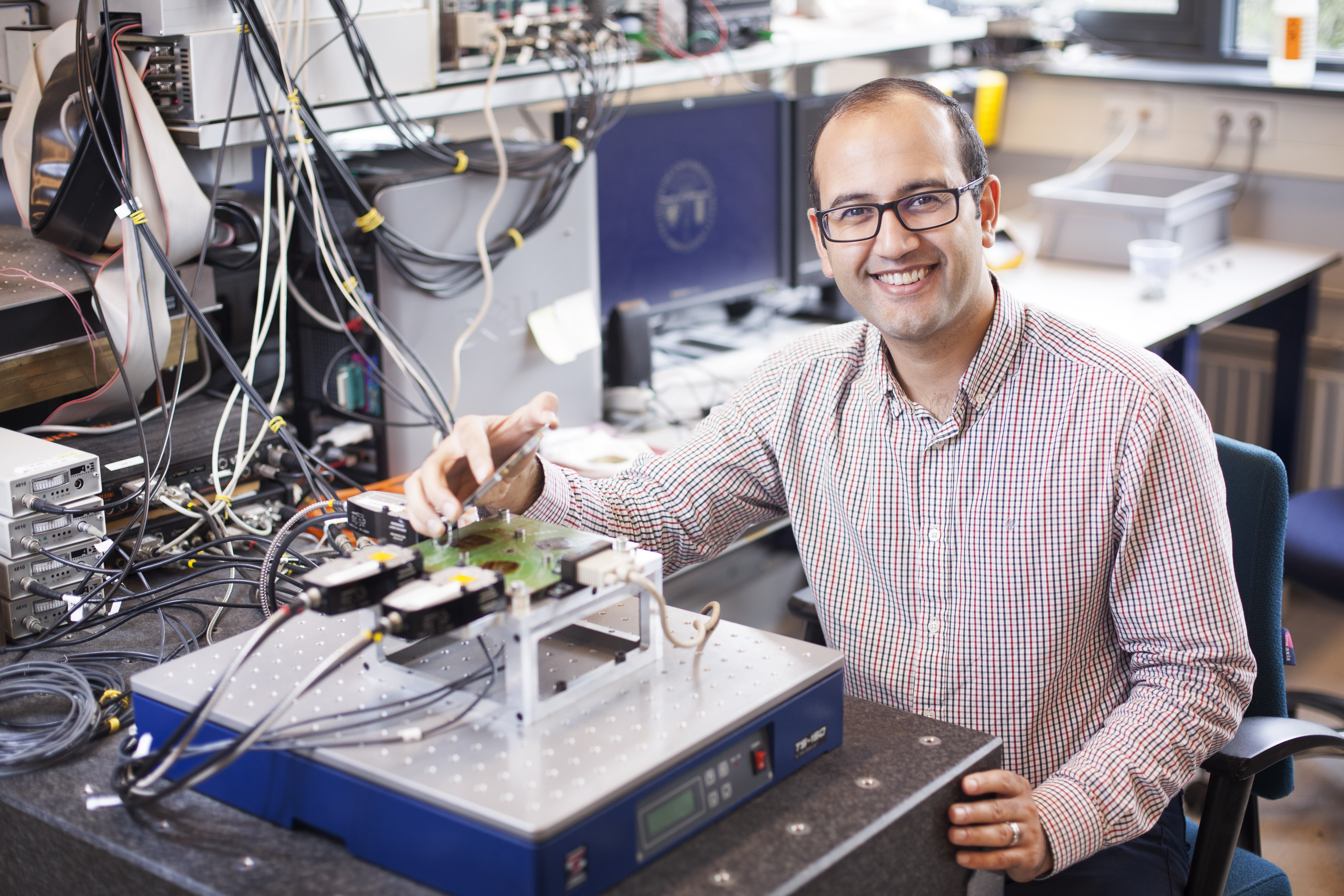‘How does one control the dosing of 0.000000000000001 litre of fluid from a hollow needle? We took the first steps by combining our expertise in micro/nanosystem design and control engineering.’
Their offices at the Dept. of Precision and Microsystems Engineering are located only a few metres from each other, yet Dr. Murali Ghatkesar and Dr. Hassan HosseinNia work in vastly different areas of mechanical engineering. Ghatkesar is an expert in micro/nano-engineering, building for example innovative systems that can dispense the tiniest liquid droplets for a wide range of futuristic applications. HosseinNia is a control engineer, working to control for example the movement of large systems to the utmost precision. The cohesion grant allowed them to join forces and learn each other’s language. ‘We wanted to develop a control system to precisely automate the dosage of droplets of as little as a femtolitre in volume.’ Their desire to arrive at a control approach that could be easily adapted to different experimental circumstances resulted in the addition of adaptive control expert Dr. Simone Baldi (Delft Centre for Systems and Control) to the team. Together, the three researchers call the project ‘a case study in mechatronic design’ and hope the promising results will pave the way for future funding applications.
Language barrier
‘We had something of a language barrier to overcome at first,’ says Ghatkesar. ‘I explained the concept of my so-called femtopipette, a cantilever with a hollow needle that can be precisely manoeuvred with an accuracy of less than a micrometre, which is a millionth of metre, and push out a femtolitre of liquid, which is equivalent to a cubic micrometre of liquid. I thought that would be sufficient for my colleagues to design the control system envisioned, but that’s not how it works. It took a few weeks of discussions for us to find common ground: we first had to develop a model of the system, clearly defining the physics, the parameters and the links between the parameters. As an engineer, I don’t usually think of the technology I’m developing in terms of model parameters.’ The model definition allowed the disciplines to connect.
‘We had something of a language barrier to overcome at first. It took a few weeks of discussions to find common ground. A model definition allowed the disciplines to connect.’
Single-cell biopsy
There are many possible applications for a pipette system that can dose femtolitre droplets. ‘Imagine a femtopipette depositing a drop of fluorescent marker fluid onto a single living cell and extracting an element of interest, guided by the markers.’ Such a tool would help researchers understand how the complex system of life functions, by allowing them to zoom in on its basic building block – the cell – and study the many different components inside it. ‘The only way to succeed in such a single-cell ‘biopsy’ is to limit the amount of liquid that is dispensed or sucked up. Too much would damage the cell.’ For this and other applications, being able to precisely control the liquid volume that is transported by the pipette is essential.
Many parameters
So, the researchers first had to come up with a model of how dosing the fluid depends on the various parameters. Complicating matters, there were a lot of parameters involved: the properties of the surface onto which the droplet is deposited, the material properties and size of the hollow needle, the viscosity and density of the fluid, and so on. To reveal the role of each parameter, lots of experiments using lots of pipettes were done. ‘The femtopipettes are fabricated using techniques common to microchip fabrication, which is quite an expensive process,’ explains Ghatkesar. As a result, the cohesion project’s budget allowed only a Master’s student to assist Ghatkesar and HosseinNia in the work. ‘Luckily, we found Mr. Xi Cao, who was very good in both the physics and control engineering aspects. It was a perfect project for him.’ And a successful one as well, as concluded from the presentation Cao was invited to give at the prestigious world congress of the International Federation of Automatic Control (IFAC). The results were well received and published as a conference paper.
‘The results were well received and published as a conference paper’
Iterative-adaptive-fractional control
Based on the resulting picture of the physics at play, HosseinNia and Baldi designed a control scheme. They came up with an integrated approach in which (1) an iterative learning control loop allows the system to learn by comparing the intended and realised droplet volumes, (2) an adaptive controller stabilises the iterative loop, adapting it to different experimental circumstances, and (3) the control loop features so-called fractional order properties to make the process more robust against unwanted disturbances. HosseinNia is especially excited about the third element. ‘The overwhelming majority of control systems used in industry are of a simple, linear type. Whenever better performance, such as higher precision or speed, is needed, the control systems become so complicated that it scares off practical use. The fractional-order approach has great potential as it represents a middle ground between high performance and easy compatibility with industry standards. He continues: ‘The combination of adaptive and fractional-order control is a theoretical novelty, which has not yet been applied to practical systems. Our cohesion project is the first.’
‘The combination of adaptive and fractional-order control is a theoretical novelty, which has not yet been applied to practical systems. Our cohesion project is the first.’
Next on the agenda
While Ghatkesar notes that they are not done yet, he looks back at a fruitful project. ‘I certainly enjoyed the collaboration.’ For control engineers HosseinNia and Baldi there were even surprises along the way. ‘We’re used to working with much larger systems. When moving to such small scales, the situation becomes so much more complex and troublesome.’ HosseinNia adds: ‘In a way, it made proud to be an experimental control engineer. The project reaffirms that control theory cannot be mindlessly applied in practice, it requires diving deep into the experimental reality.’ Although the cohesion project has ended and their MSc student moved on to a PhD position at the University of Eindhoven, the collaboration continues. Testing their newly developed control approach in real-time experiments is next on the agenda of Ghatkesar, HosseinNia and Baldi.
Dr. Hassan HosseinNia (Dept. of Precision and Microsystems Engineering) received his PhD degree cum laude in electrical engineering, specialising in automatic control, from the University of Extremadura, Spain. He also has an industrial background working at ABB, Sweden. In 2014 he was appointed as assistant professor at TU Delft. His work centres on precision mechatronic system design, precision motion control and mechatronic systems with distributed actuation and sensing.
Dr. Murali Ghatkesar (Dept. of Precision and Microsystems Engineering) graduated summa cum laude from the University of Basel in Switzerland. After that he worked among others at CalTech and the University of Virginia in the US. As assistant professor ‘Micro and Nano Engineering’ at the TU Delft he develops micro and nanotechnology-based tools to help solve intriguing problems in chemistry/biology and unravel some of the mysteries of nature at small scales.
Dr. Simone Baldi (Delft Centre for Systems and Control) obtained his PhD from the University of Florence in 2011. Subsequently, he held postdoctoral researcher positions in Greece and Cyprus. Since 2014 he is an assistant professor (tenure-track) at the Delft Centre for Systems and Control. His main research interests are in the area of control theory and include adaptive control, adaptive optimisation techniques for control of large-scale systems, and switching supervisory control with multiple models.
ME Cohesionprojects
The cohesion projects were launched in 2014 based on an idea by Dean Theun Baller, the aim of which is to encourage interdisciplinary cooperation within the faculty. A good engineer, after all, is inherently good at working with others, and most innovations take place on the cutting edge of disciplines. The cohesion projects give young researchers the opportunity to ask for funding for projects, on the condition that they work together with colleagues within the faculty and outside their own discipline. Mechanical Engineering, Maritime Technology and Materials Science have proven to be extremely suitable for unexpected cross-overs with surprising outcomes.



